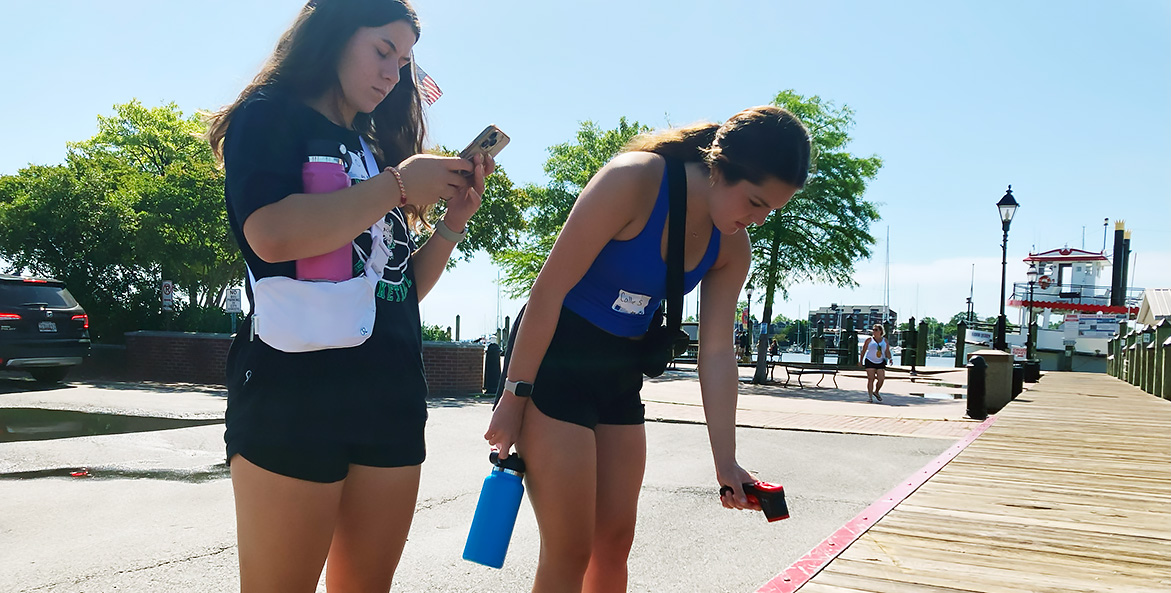On a blue-sky day in late May, 60 students from Arundel High School gathered at the Annapolis City Dock. Behind them, a high tide pushed the waters of Ego Alley, the city’s famous canal, just over the lip of a bulkhead at the dock’s inland end. It was a fitting, if unsettling, background for their topic of study: community resilience to climate change.
“I think it’s really important that we help resolve climate change. As you can see all around the world, it’s actually real. It’s changing the world significantly,” said sophomore Savannah Kishis.
“Especially here in DTA [Downtown Annapolis], where all of the sea level rise is,” added Annastasia Kazzi, a junior.
They gestured at the water behind them. “This is flooding right now.”
Rapidly rising sea level in Annapolis, and throughout the Chesapeake Bay region, is just one of the many ways climate change is impacting the Bay’s communities and ecosystems. Extreme storms are washing more pollution into the water; heat waves and rising temperatures are stressing cold-water species like brook trout and striped bass; and saltwater is inundating farmland and forests.
It all heralds a radically different future for today’s students—and educators are racing to prepare them for it.
“As climate change is becoming more and more important in our everyday lives, we want to ensure we are passing on to the next generation that they have a role in this” said Lejae Woolcock, the Baltimore and D.C. Education Outreach Coordinator at CBF. “They are super important for building up resiliency and the actions we can take against it.”
Yet there is a long way to go. In 2020, New Jersey became the first state in the country to include climate change in its state education standards, requiring it to be taught across grade levels and subjects. Connecticut and California followed in 2022 and 2023, respectively, requiring climate change to be taught as part of state science standards. Other states, including New York, have introduced similar legislation, but climate standards remain uncommon nationally.
The lack of state-level support isn’t only a challenge for students and teachers; it is also a concern for those who care about fragile ecosystems like the Chesapeake Bay.
At the Chesapeake Bay Foundation, we are very concerned about the impacts of climate change on the Chesapeake Bay ecosystem and its communities. Because of that, we’re very interested in people engaging with it, asking questions, and thinking about solutions.
However, that can be a challenge because even where it is taught, climate education is overwhelmingly classroom-based and abstract.
One of the biggest hurdles is that climate change seems like this large, global phenomenon that nobody can do anything about. A lot of times that creates climate anxiety, or just frustration, and then people pull away from it.
To help overcome these barriers, last summer CBF’s Professional Learning Team joined with teachers from Anne Arundel County Public Schools and Prince George’s County Public Schools in Maryland to develop a different approach. How, we wondered, could we get students outside, actively collecting first-hand data about climate change in their own Chesapeake Bay communities, and thinking about possible solutions?
Over this past school year, the teachers began incorporating the new investigations into their classrooms on a pilot basis, leading up to the very first field experience in Annapolis this May.
“This has been a year-long work in progress, the partnership between Anne Arundel County Public Schools and Chesapeake Bay Foundation” said Christine Oxman, who teaches AP Environmental Science at Arundel High School and serves as Science Department Chair. “We’re studying climate resiliency and looking at how our community is impacted by climate change, and this is the culmination of classroom meets Annapolis.”
During their day in the state capital, her classes investigated the urban heat island effect using infrared temperature sensors to see which surfaces and areas of the city were hotter—and cooler—than others. They also surveyed community members about how well they think Annapolis is prepared for climate change. Working with CBF GIS Program Manager Katie Leaverton, they then used GIS to map and analyze the data they collected in real-time.
“It’s so important that our students have this experience because it takes what we’ve been talking about inside the four walls of our school building and brings it out into the real world, and it shows them that science is all around us,” said Oxman. “It makes the education real.”
The field experience was just one component of the students’ in-depth research into climate resiliency. For their final project, they were tasked with applying their understanding to the real-world challenges facing Anne Arundel County and the Bay. After returning to the classroom, they incorporated the data they collected in the field, along with projected climate data and historical records, to create an interactive ArcGIS StoryMap illustrating how factors like land use and sea level rise impact the community’s resilience. Ultimately, the story map will be shared with members of the local community to help inform plans for increasing resiliency.
“I feel like we’re learning a lot, and it’s preparing us for the future and how to solve this,” Kishis said.




